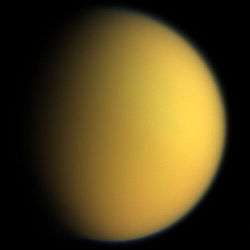Kraken Mare
|
False-color mosaic of synthetic aperture radar images showing all of Kraken Mare. The large island Mayda Insula is left of top center, and Jingpo Lacus is at upper left. A portion of Ligeia Mare enters the view at top right. | |
| Feature type | Mare |
|---|---|
| Coordinates | 68°N 310°W / 68°N 310°WCoordinates: 68°N 310°W / 68°N 310°W |
| Diameter | 1,170 km[note 1] |
| Eponym | Kraken |
Kraken Mare is the largest known body of liquid on the surface of Saturn's moon Titan. It was discovered by the space probe Cassini and was named in 2008 after the Kraken, a legendary sea monster.[1]
Description
At 400,000 km²,[2] Kraken Mare is thought to be the largest body of liquid in Titan's north polar region.[1] The maximum depth appears to be 160 meters and shallow capillary waves 1.5 centimeters high moving at 0.7 meters per second have been detected. [3] Its status as a sea of hydrocarbons (mainly liquid methane) was identified by radar imagery. Kraken Mare is thought to be larger than the Caspian Sea on Earth.
An island in the sea is named Mayda Insula. Kraken Mare may be hydrologically connected to the second-largest sea on Titan, Ligeia Mare.[4]
The narrow constriction in the sea at 317°W, 67°N, about 17 km wide and similar in size to the Strait of Gibraltar, officially named Seldon Fretum,[5] has been termed the 'Throat of Kraken' and suggested to be a location of significant currents.[6] Titan's orbital eccentricity may lead to tides of 1 m in Kraken Mare, generating currents here of 0.5 m/s and possibly whirlpools.[4]
As part of the proposed Titan Saturn System Mission, a probe would splash down on Kraken Mare in order to scrutinize its composition, depth and numerous other properties.
Gallery
 Synthetic aperture radar image (top) overlaid onto a visible light/infrared image of Titan's north polar region, showing the full extent of Kraken Mare.
Synthetic aperture radar image (top) overlaid onto a visible light/infrared image of Titan's north polar region, showing the full extent of Kraken Mare. Radar image showing the northern portion of Kraken Mare, including the large island Mayda Insula.
Radar image showing the northern portion of Kraken Mare, including the large island Mayda Insula. Radar image of a portion of Kraken Mare with a rugged coastline and numerous islands.
Radar image of a portion of Kraken Mare with a rugged coastline and numerous islands. Specular reflection off Jingpo Lacus in the Kraken Mare region, observed by Cassini on July 8, 2009.
Specular reflection off Jingpo Lacus in the Kraken Mare region, observed by Cassini on July 8, 2009.
Notes
- ↑ The USGS web site gives the size as a "diameter", but it is actually the length in the longest dimension.
References
- 1 2 "Kraken Mare". Gazetteer of Planetary Nomenclature. USGS Astrogeology Science Center. Retrieved 2012-03-16.
- ↑ "Titan's Northern Polar Clouds". NASA JPL. March 17, 2011. Text summary. Retrieved 2016-01-23.
- ↑ Hand, Eric (December 16, 2014). "Spacecraft spots probable waves on Titan's seas". Science. Retrieved 2015-01-14.
- 1 2 Lorenz, R. D. (2014). The Throat of Kraken : Tidal Dissipation and Mixing Timescales in Titan’s Largest Sea (PDF). 45th Lunar and Planetary Science Conference (2014). The Woodlands, Texas. p. 1476. Retrieved 2014-06-09.
- ↑ "Seldon Fretum". USGS planetary nomenclature page. USGS. Retrieved 2015-05-23.
- ↑ Rincon, P. (2014-03-18). "'Waves' detected on Titan moon's lakes". BBC web site. BBC. Archived from the original on 2014-05-31. Retrieved 2014-06-09.
External links
| Wikimedia Commons has media related to Kraken Mare. |

